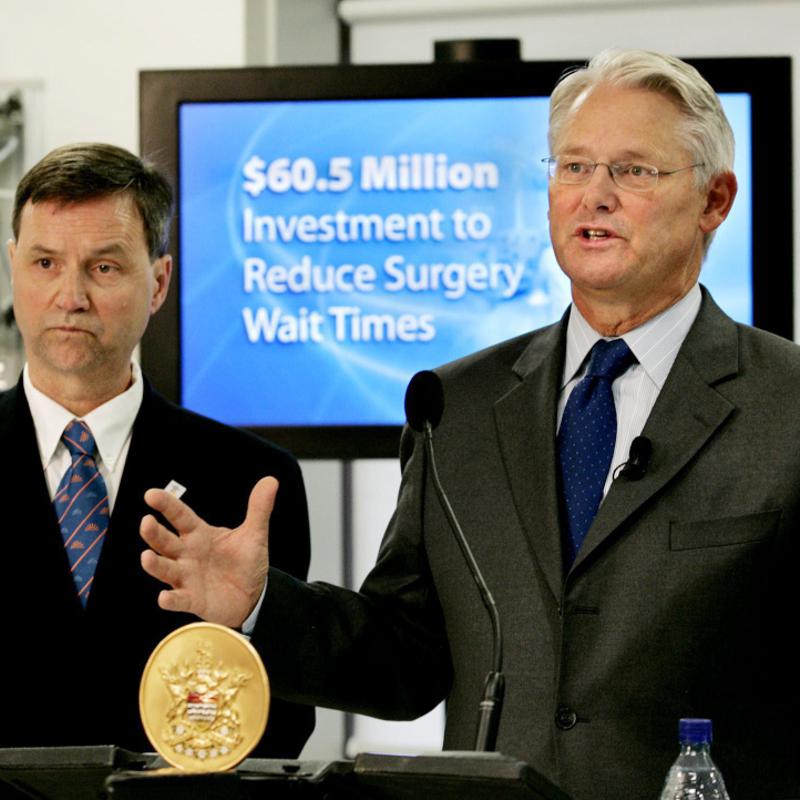Former cabinet minister and current treaty commissioner George Abbott’s new book provides a timely reminder that British Columbia’s current struggles around Indigenous rights and title are the direct result of past government decisions over many years.
Available from UBC Press imprint Purich Books, Unceded: Understanding British Columbia’s Colonial Past and Why It Matters Now traces how successive governments treated the “land question” going back to the formation of the colonies and tracks repeated failures to try to settle it.
The book comes as the province grapples with major court decisions around Aboriginal title and MLAs argue over whether the Declaration on the Rights of Indigenous Peoples Act should be repealed or just revised, in either case over the objections of Indigenous leaders.
“We’re now having to deal in 2026 with issues that might have been remedied effectively 170 years ago, but were not,” Abbott told The Tyee in an interview. “We’re paying for the failures of the ancestors, and the courts are saying very clearly you have to do that. It’s not an option to put it off another 170 years.”
The Supreme Court of British Columbia’s decision last summer in Cowichan Tribes v. Canada, and the political response to it, is a prime example.
In the lengthy ruling, Justice Barbara M. Young found the descendants of the Quwʼutsun Nation have Aboriginal title to about 780 acres of Tl’uqtinus, their summer fishing village on the south arm of the Fraser River, and have an Aboriginal right to fish for food in the area.
The Crown had unjustifiably infringed on the Quwʼutsun Nation’s Aboriginal title, she found, and declared the federal government and the City of Richmond’s titles to some of the lands defective and invalid.
The ruling left other private property intact. But it said “B.C. has a duty to negotiate with the Cowichan to reconcile their Aboriginal title with the private fee simple interests in a manner that accords with the honour of the Crown.”
Abbott called the decision important and said it will be interesting to see what happens as it goes through two levels of appeal.
“I think the justice got most of the decision right,” he said. “I think she did a pretty good job on the history.... She established very clearly that Cowichan Tribes, or today Cowichan Nations, made good use of their opportunity to fish on the Fraser River, as did many other nations.”
However, going the further step of calling into question the titles to fee simple private land in the area — something the Quwʼutsun plaintiffs were not seeking — may have the opposite effect from what the justice imagined, Abbott said.
“Rather than encouraging the parties to negotiate, it encouraged them to appeal, for different reasons,” he said.
“From what I know of government it’s not something that would move the matters along” and would instead make it more complicated, he said. “I don’t think Justice Young’s decision left government in a strong negotiating position, and I suspect that’s part of the calculus moving forward.... It’s a tough decision to work from politically.”
While Abbott stresses that he is happily no longer a politician, he did sit many years at the cabinet table. He was the MLA for Shuswap for 17 years under BC Liberal premiers Gordon Campbell and Christy Clark with assignments that included minister of Aboriginal relations and reconciliation and minister of health.
After leaving office he earned a PhD in political science from the University of Victoria, turning his thesis into the book Big Promises, Small Government: Doing Less with Less in the BC Liberal New Era.
Abbott’s new book is also rooted in his experience in government. “I met more than a few colonial ghosts,” he wrote, “while serving as British Columbia’s minister of Aboriginal services from 2001 to 2004 and minister of Aboriginal relations and reconciliation from 2009 to 2010.”
A 2010 visit to Tsay Keh Dene village left a particularly strong impression. The people he met had much of their traditional territories flooded in 1968 with the filling of the Williston reservoir.
“How could such injustices have occurred only a few decades earlier?” asked Abbott. “The Tsay Keh Dene had been uprooted by my predecessors in government, rendered ‘refugees on their own lands,’ then capriciously neglected and disregarded in the years that followed.”
Nor were they alone in the “callous treatment they suffered at the hands of the government,” he wrote.
As Abbott thoroughly documents, the pattern was in place almost from the founding of the colonies that became British Columbia. While Gov. James Douglas took a relatively enlightened approach, leaving it up to First Nations to determine what land they needed, later governments resisted and undermined efforts to establish fair reserves.
One of the more important elements in the book, Abbott said, is the examination of British Columbia’s policy from Douglas’s retirement until the 1920s to create reserves only as white settlement proceeded. It was the opposite approach from what Canada had taken east of the Rocky Mountains, where treaties were negotiated ahead of white settlement.
The reserves in B.C. were also much smaller than those created in other parts of the country, especially on the coast, he said, setting the stage for decades of conflict.
“It did not have to be this way,” wrote Abbott. “A more constructive path was followed during the early colonial years under Governor James Douglas, but his approach crashed up against settler resistance, ushering in the brutal racism of Joseph Trutch and William Smithe and innumerable injustices in the century of darkness that followed.”
After replacing Douglas, Trutch became B.C.’s first lieutenant-governor. Smithe was premier from 1883 to 1887.
“Trutch dismissed the notion of Aboriginal title out of hand, as most of his successors would for the next 125 years,” wrote Abbott, tracing to him the theme that Indigenous people were a barrier to economic development instead of partners in it.
“Trutch’s views were rooted at the far end of settler racism,” Abbott wrote in another section. “He used the power of his political offices — along with lies and intimidation, when needed — to undermine Douglas’s vision for Indigenous relations.”
Abbott said he learned much in working on the chapters about the Royal Commission on Indian Affairs for the Province of British Columbia, known as the McKenna-McBride commission, conducted between 1913 and 1916.
He was astonished at the number of First Nations who returned from their seasonal rounds to a site they’d long occupied only to find it had been taken over by the province, he said. “Those kinds of situations have occurred around the province and to me that’s why we need as quickly as we can to get treaties with First Nations that recognize past injustices, or I’m also very supportive of foundation agreements.”
Foundation agreements, like the one signed with the Lake Babine Nation in 2020, aren’t a full treaty settlement but include many of the same measures, he said.
Abbott doesn’t shy from acknowledging how his views, or at least his willingness to champion them, have changed over the years.
In writing about the NDP’s approach in opposition under Carole James’ leadership, he said: “To her credit, James recognized an uncomfortable truth that [former premier Gordon] Campbell and the BC Liberals (including me) had chosen to ignore in the context of the Nisga’a Treaty debates in the latter 1990s: the benefits of advancing reconciliation and remediating past injustices through treaty making can be all too easily lost in the cut and thrust of parliamentary debate and tactical partisan positioning.”
Similarly, he expresses relief that Campbell’s 2009 election campaign kept reconciliation in the background. “BC Liberal MLAs (like me) who believed that economic management was a far safer electoral battleground than a Recognition and Reconciliation Act had good reason to be pleased with Campbell’s election campaign and its outcome.”
There is also blame for others who stalled progress, in particular Campbell’s successor Christy Clark. “Premier Clark did not share her predecessor’s fascination with public policy as an instrument of reform,” wrote Abbott. “There would be no big and bold Indigenous relations initiatives during her tenure.... Indigenous relations was of interest only when it facilitated economic development.”

Cowichan Decision and Beyond: Letting Go of Zero-Sum Thinking
read more
He also addresses the Clark government’s strange last-minute revoking of his appointment as the BC Treaty Commission’s chief commissioner in 2015, six months after then-Aboriginal affairs minister John Rustad recruited him, though to this day he’s unsure what drove the decision.
His current appointment to the commission was made last year by the NDP government.
The book includes a useful chronology that covers from 1846 to 2024, as well as extensive endnotes, an index and recommendations for further reading, including works by Indigenous and non-Indigenous writers.
In general, Abbott said, he’s optimistic the province is moving in the right direction on reconciliation. While there is rhetoric in the legislature from some members, particularly OneBC leader and Vancouver-Quilchena MLA Dallas Brodie, that hasn’t been seen in decades, he said; most support moving ahead.
“The great majority of members of the assembly, whether they are Conservative or New Democrat, want the treaty process to be effective and see a reconciliation of the injustices of the past,” he said. “I think there is a broad consensus in the assembly that we should remedy injustice and move along the path to reconciliation as quickly as we can.”
In the book Abbott said he hopes to bring the lessons he learned while writing it to his work with the BC Treaty Commission.
“There are dozens of situations where injustices have been imposed as a consequence of historical policies by the government of British Columbia,” Abbott told The Tyee, adding that identifying and remedying them are a big part of reconciliation.

George Abbott Looks Back at the BC Liberals New Era, and Doesn’t Like What He Sees
read more
Abbott’s book includes a foreword by Steven Point, former Grand Chief of the Stó:lō Tribal Council, provincial court judge and the province’s first Indigenous lieutenant-governor.
“The simple truth is that when Europeans arrived in the so-called New World, they did not find an empty land but rather a land with millions of Indigenous people who already owned and occupied their homelands,” he wrote.
“Aboriginal title to the land in British Columbia is a legal reality and must be dealt with in our time, if we can,” he said, adding that, despite Canada being one of the wealthiest countries on the planet, most Indigenous people live in developing-world conditions on federal reserves.
“We have to conclude respectful treaties that will allow First Nations real benefits from their own homelands,” Point wrote. “A share in the resources being extracted would allow First Nations to finance their own healing from our oppressive colonial past.”
At a time when there seems to be growing confusion about the way forward and weakening commitment to reconciliation, Unceded grounds the current debates in B.C.’s colonial history and argues for a better future. ![[Tyee]](https://thetyee.ca/design-article.thetyee.ca/ui/img/yellowblob.png)




![[Tyee]](https://thetyee.ca/design-article.thetyee.ca/ui/img/yellowblob.png)
 : DTEK
: DTEK